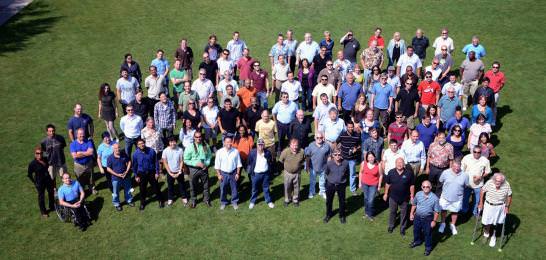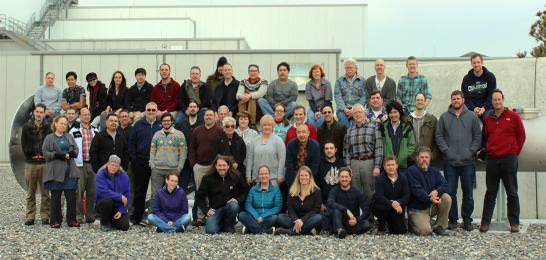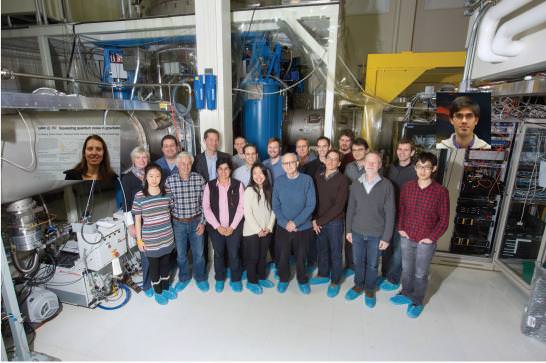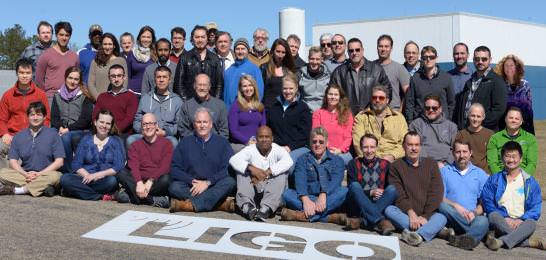2016 Gruber Cosmology Prize Press Release
| Media Contact: | |
| A. Sarah Hreha The Gruber Foundation +1 (203) 432-6231 info@gruber.yale.edu | |
| Online Newsroom: www.gruber.yale.edu/news-media | |
| FOR IMMEDIATE RELEASE |
Drever, Thorne, and Weiss Receive $500,000 Gruber Cosmology Prize for Detection of Gravitational Waves
   |
| Ronald W. P. Drever Kip Thorne Rainer Weiss |
May 4, 2016, New Haven, CT – The 2016 Gruber Foundation Cosmology Prize recognizes Ronald Drever, Kip Thorne, Rainer Weiss, and the entire Laser Interferometer Gravitational-Wave Observatory (LIGO) discovery team for the first observation of gravitational waves, ripples in space-time predicted by Einstein a century ago.
The citation praises the recipients for “pursuing a vision to observe the universe in gravitational waves, leading to a first detection.” That detection, which took place in 2015, provided long-sought support for a key prediction of Einstein’s general theory of relativity, itself a technologically herculean and scientifically transcendent achievement. But the detection also represents a new means of studying the universe—“the first glimpse into the strong-gravity regime of Einstein’s theory of general relativity,” the part of the theory that governs the dynamics of the most gravitationally powerful phenomena in the universe.
Drever, Thorne, and Weiss will divide the $500,000 award equally, and each will also receive a gold medal. The award ceremony will take place on July 12 at the 21st International Conference on General Relativity and Gravitation, held at Columbia University, New York.
The LIGO team’s announcement of the detection this past February 11 electrified the physics community and captured the imagination of media outlets around the world. “The Chirp Heard Across the Universe” read the headline of a celebratory New York Times editorial, referring to a translation of the gravitational waves into sound waves. The source of the birdlike sound, however, was anything but benign: the collision of two black holes.
One hundred years ago, Einstein’s theory of general relativity reimagined Newton’s conception of gravity. Rather than treating gravity as a force acting across space, Einstein’s equations revealed gravity to be a property of space and time. In that case, Einstein realized, gravity would act in waves traveling at the speed of light, and those waves would be crashing through Earth all the time, only so faintly that they would be impossible to detect—or so it was thought.
In the 1960s, however, several researchers in the Soviet Union and the United States independently proposed a means for making that detection: a laser interferometer, a device that simultaneously sends two light signals down different paths and measures their arrival times at a common destination. The arrival times should be simultaneous as well, unless something has interfered with the two light waves during their separate journeys. At least in principle, the researchers argued, gravitational waves could be that something. These ripples in space-time would change the length of the arms and therefore the travel times for the light.
Among the U.S. researchers advocating that approach was Rainer Weiss, a physicist at the Massachusetts Institute of Technology. By 1972 he had completed an in depth analysis of many of the major sources of noise that such an interferometer would encounter, and had developed a detailed design for a gravitational wave detector that would surmount those noises. This became a blueprint for two decades of R&D leading to LIGO.
During the same period Kip S. Thorne founded a research group at the California Institute of Technology (Caltech) to study the theoretical side of gravitational waves. In 1975, when Thorne asked Weiss what experiments Caltech could create to complement the theoretical work, Weiss convinced him that an interferometer at a large enough scale actually had a realistic chance of detecting gravitational waves.
To lead that group Thorne and Caltech in 1979 recruited Ronald Drever from the University of Glasgow; Drever himself had been one of that decade’s leading creators of gravitational-wave interferometer prototypes.
In 1984 Caltech and MIT signed an agreement for the joint design and construction of LIGO, with administrative headquarters at Caltech, and with joint leadership by Drever, Weiss, and Thorne. In 1986 a NSF review committee urged that LIGO be managed by a single director. Shortly thereafter Rochus Vogt became LIGO’s first director and guided the joint Caltech and MIT groups in writing the major proposal which succeeded in obtaining funding from the NSF for LIGO in 1992. For success LIGO had to transition from a small R&D project to a large, multi-university, international collaboration; that transition was led by Barry Barish, the second director of LIGO, who designed the collaboration and oversaw the construction, installation, and commissioning of the interferometers, as well as the first searches for gravitational waves.
LIGO would consist of two interferometers, in part to guard against a single false-positive detection; one instrument would be in Louisiana, the other in Washington. At each location, laser light would travel back and forth along two four-kilometer arms.
The experiment would also operate in two phases. The first would be a dry run of sorts, the second would follow a significant technological upgrade. It was at the beginning of this second phase—on September 14, 2015—that LIGO registered the telltale difference in arrival times precisely corresponding to the disruption in space-time that would be caused by the collision of two black holes.
“Certainly I was surprised,” Thorne says at how quickly LIGO made the first detection. “But not too surprised.” The measurement, after all, was what the experiment had been designed to find. “You get the apparatus to a certain point,” Weiss says, “stop commissioning put your hands in your pockets and just watch for a while.”
If any part of the discovery was a surprise, it was that the first detection came from the collision of two black holes, perhaps the least common of the phenomena in Einstein’s strong-gravity regime—the kind that disturb space-time to such an extent that LIGO could register the aftershocks. Other candidates for future observation include exploding stars (supernovae), spinning neutron stars (stars with a radius of about seven miles yet holding twice the mass of the Sun), even colliding neutron stars.
But black holes it was—two of them in the 30-solar-mass range about 1.3 billion light-years from Earth, their gravitational fields spiraling them together into increasingly close, increasingly fast, and ultimately fatal orbits. Now that the LIGO team knows the experiment works, they’re confident that other strong-gravity detections will become more or less routine, perhaps reaching the rate of a few per month.
The universe is vast and violent: The new field of gravity-wave detection should have no shortage of discoveries.
Additional Information
The Prize citation reads:
The Gruber Foundation proudly presents the 2016 Cosmology Prize to Rainer Weiss, Kip Thorne, Ronald Drever, and the entire LIGO team for pursuing a vision to observe the universe in gravitational waves, leading to a first detection that emanated from the collision of two black holes.
This remarkable event provided the first glimpse into the strong‐gravity regime of Einstein's theory of general relativity that governs the dynamics of black holes, giving direct evidence for their existence, and demonstrating that their nature is consistent with the predictions of general relativity.
* * *
Laureates of the Gruber Cosmology Prize:
- 2015: John Carlstrom, Jeremiah Ostriker, and Lyman Page, for their individual and collective contributions to the study of the universe on the largest scales
- 2014: Jaan Einasto, Kenneth Freeman, Brent Tully and Sidney van den Bergh for their pioneering contributions to the understanding of the structure and composition of the nearby Universe
- 2013: Viatcheslav Mukhanov and Alexei Starobinsky for their profound contribution to inflationary cosmology and the theory of inflationary perturbations of the metric. These developments changed our views on the origin of our universe and on the mechanism of formation of its structure
- 2012: Charles Bennett and the WMAP Team for their exquisite measurements of anisotropies in the relic radiation from the Big Bang---the Cosmic Microwave Background
- 2011: Marc Davis, George Efstathiou, Carlos Frenk and Simon White for their pioneering use of numerical simulations to model and interpret the large-scale distribution of matter in the Universe
- 2010: Charles Steidel for his groundbreaking studies of the distant Universe
- 2009: Wendy Freedman, Robert Kennicutt and Jeremy Mould for the definitive measurement of the rate of expansion of the universe, Hubble's Constant
- 2008: J. Richard Bond for his pioneering contributions to our understanding of the development of structures in the universe
- 2007: Saul Perlmutter and Brian Schmidt and their teams: the Supernova Cosmology Project and the High-z Supernova Search Team, for independently discovering that the expansion of the universe is accelerating
- 2006: John Mather and the Cosmic Background Explorer (COBE) Team for studies confirming that our universe was born in a hot Big Bang
- 2005: James E. Gunn for leading the design of a silicon-based camera for the Hubble Space Telescope and developing the original concept for the Sloan Digital Sky Survey
- 2004: Alan Guth and Andrei Linde for their roles in developing and refining the theory of cosmic inflation
- 2003: Rashid Alievich Sunyaev for his pioneering work on the nature of the cosmic microwave background and its interaction with intervening matter
- 2002: Vera Rubin for discovering that much of the universe is unseen black matter, through her studies of the rotation of spiral galaxies
- 2001: Martin Rees for his extraordinary intuition in unraveling the complexities of the universe
- 2000: Allan R. Sandage and Phillip J. E. (Jim) Peebles: Sandage for pursuing the true values of the Hubble constant, the deceleration parameter and the age of the universe; Peebles for advancing our understanding of how energy and matter formed the rich patterns of galaxies observed today
The Prize recipients are chosen by the Cosmology Selection Advisory Board. Its members are:
Andrew Fabian, University of Cambridge; Robert Kennicutt, University of Cambridge (Chair); Helge Kragh, Niels Bohr Institute; Sadanori Okamura, Hosei University; Frans Pretorius, Princeton University; Subir Sarkar, University of Oxford; and Rashid Sunyaev, Max Planck Institute for Astrophysics. Owen Gingerich of the Harvard-Smithsonian Center for Astrophysics and Martin Rees of the University of Cambridge also serve as special Cosmology advisors to the Foundation.
* * *
By agreement made in the spring of 2011 The Gruber Foundation has now been established at Yale University.
The Gruber International Prize Program honors individuals in the fields of Cosmology, Genetics and Neuroscience, whose groundbreaking work provides new models that inspire and enable fundamental shifts in knowledge and culture. The Selection Advisory Boards choose individuals whose contributions in their respective fields advance our knowledge and potentially have a profound impact on our lives.
The Cosmology Prize honors a leading cosmologist, astronomer, astrophysicist or scientific philosopher for theoretical, analytical, conceptual or observational discoveries leading to fundamental advances in our understanding of the universe.
* * *
For more information on the Gruber Prizes, visit www.gruber.yale.edu, e-mail info@gruber.yale.edu or contact A. Sarah Hreha at +1 (203) 432-6231. By mail: The Gruber Foundation, Yale University, Office of Development, PO Box 2038, New Haven, CT 06521.
Media materials and additional background information on the Gruber Prizes can be found at our online newsroom: www.gruber.yale.edu/news-media
| The LIGO Team comprises more than 1000 people at over 70 different institutions |
| LIGO Group at Caltech |
 |
| LIGO Group at Hanford |
 |
| LIGO Group at MIT |
 |
| LIGO Group at Livingston |
 |





